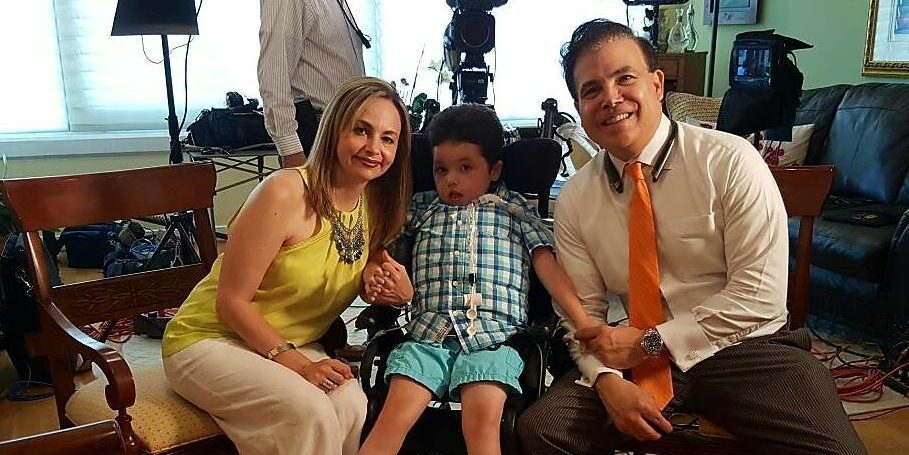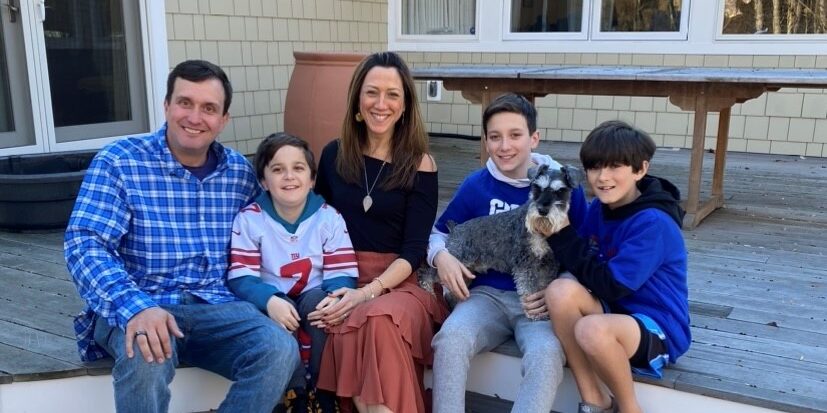
My Gene Therapy Journey: The Curran Family
By Rebecca Hume | Thursday, September 5, 2024
5 Second Summary
Gene therapies are increasingly available for muscular dystrophies and other neuromuscular diseases. My Gene Therapy Journey is a Quest Media series that gives members of the neuromuscular community a platform to share their experiences with gene therapies — both approved therapies and those in clinical trials — and provides essential information to help individuals and families make decisions about gene therapies.
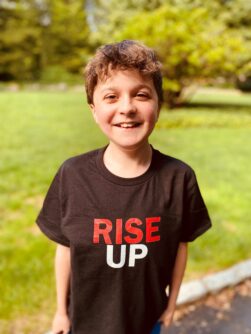
Conner Curran
Conner Curran made history when he became the first child to receive gene therapy treatment for Duchenne muscular dystrophy (DMD) in a 2018 Pfizer clinical trial. Clinical trials like the one that Conner participated in would lead to the 2023 FDA approval of Sarepta’s Elevydis, a life changing gene therapy treatment. Elevydis brings hope for a better future to families and children with DMD, a future that Conner’s parents, Jessica and Chris, were told would not occur in Conner’s lifetime. Despite the lack of treatment options at the time of Conner’s diagnosis, Jessica and Chris’s unwavering faith, advocacy, and dedication to raising funds for research have propelled them on their gene therapy journey – a journey that brought to fruition the hope that they once prayed for.
Holding on to hope
In 2010, Jessica and Chris welcomed twin boys into the world. Conner and his brother, Kyle, brought to life Jessica’s dream of building a family, which would eventually grow to include their younger brother, William. During his first few years, Conner hit developmental milestones after his twin brother. When Conner was four years old, his parents took him to a developmental pediatrician who suspected that Conner might have DMD. After testing CK levels, the Curran’s were referred to a genetic specialist to confirm the diagnosis. Jessica and Chris began doing their own research to learn more about DMD and treatments options while they waited for the results of further testing. At that time, in 2015, the only treatments available for children with DMD were steroids and anti-inflammatory medications – and there was little hope in the drug pipeline. Then Chris located an article by Bamboo Therapeutics about potential clinical trials and the idea of an innovative treatment on the horizon: gene therapy.
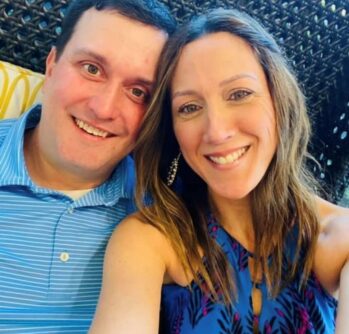
Christopher and Jessica Curran
When the Currans returned to the genetic specialist and were given Conner’s official diagnosis, Chris brought the article with him. Jessica recalls the diagnosing doctor’s shocking lack of bedside manner, sharing that he basically told them that there will not be any treatments in Conner’s lifetime and that they should just go home and give him the best life that they could as his disease progressed.
“Chris had been burning the midnight oil researching options for Conner, and he had this article by Bamboo Therapeutics in his hands at the appointment,” Jessica says. “He showed it to the doctor and asked about gene therapy in the future and the doctor basically laughed at him and said not to put any hope in that idea.”
The Currans did just the opposite though. After spending the next two and half years researching options, raising money for research, and scouring the internet for potential clinical trials, Chris found three clinical trials researching the ideas proposed in the article he had read years ago. Self-proclaimed “squeaky wheels”, Jess and Chris called the trial teams incessantly, being told each time that the trials were not accepting patients. All of that changed when they received a call from a representative at Pfizer saying that a potential trial candidate had not passed screening tests and that there was an opening in their gene therapy trial.
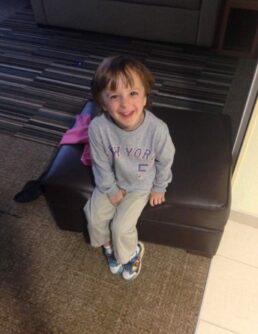
Conner on diagnosis day
“The clinical trial was Duke Medical in North Carolina, and they told us that we needed to be down there for screening the next day,” Jessica says. The Currans packed their bags and left their home in Connecticut in a flurry, eager and excited for the life-changing opportunity. “It was our wildest dreams coming true. It was a Godsend that we were able to go down there and screen for it after all those years holding on to hope for gene therapy.”
The first to receive innovative treatment
Conner met the requirements for the clinical trial and was scheduled to receive treatment – a treatment that brought hope but also brought a lot of unknowns. Although the Curran’s had spent so much time and energy hoping and praying for this treatment, the night before Conner’s scheduled infusion, Jessica began to worry about the potential risks.
“I started getting cold feet. I was looking at Conner sleeping, just this little 7-year-old kid, and I worried if we were doing the right thing. I thought, he is doing okay right now and what if something happens tomorrow, because I knew of the dangers,” Jessica says. “My husband looked at me and said we have to both be in this together and if you don’t want to do it then I will support you, but we know the alternative with this disease. He said it is going to take and take and take; and if we don’t do anything, it will end in death. That is the progress of the disease. This is a chance to extend Conner’s life. He asked me what I thought Conner would decide if he were able to make this decision. I thought about it, and said, ‘Let’s do this.’”

Conner visiting the lab that created his gene therapy treatment
Conner received the two- and half-hour gene therapy infusion the next day, becoming the very first patient to obtain the Pfizer treatment. The article that Chris had brought into that diagnostic appointment years ago was about Bamboo Pharmaceuticals, a company owned by Jude Samulski that was eventually sold to Pfizer, and the treatment mentioned in that article evolved to become the very treatment that Conner received. The Currans are now close friends with Jude. Conner’s participation in the trial contributed to the approval of gene therapy for DMD, changing the lives of countless families across the country.
A brighter future
The Currans began to see improvements in Conner’s mobility about three months after treatment. Prior to treatment, he was still walking but had limited energy and difficulty running or navigating stairs. After his parents started to see the positive effects of treatment, Conner was able to climb stairs quickly and run around to play with his friends on the playground.
“One day he said to me, ‘Mom, I don’t have to watch the kids play anymore. I don’t have to be the camera guy anymore.’ He used to be the “camera guy” when his friends played, and he would have an imaginary camera and pretend to record them playing. He used to stand around and watch them but now he didn’t have to do that because he could play too,” Jessica remembers. “Gene therapy gave him years of playing and keeping up with his friends, playing T-ball and soccer. It gave him a childhood that he wouldn’t have had without gene therapy. I believe that he is still walking today because of treatment.”
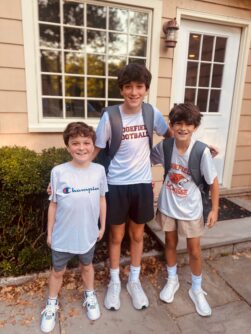
Conner, Kyle, and William
Now, six years after treatment, Conner is an active 8th grader who loves spending time with his brothers and friends. His parents note that his mobility is beginning to decrease as time goes on, but they continue to hope for future redosing or other treatment options. Conner uses a scooter for long distances and in the hallways at school but walks around his classroom and home. He has a stairlift at home because he is no longer able to go up and down the steps. Conner also now has difficulty getting up from the floor independently. He has slight dexterity issues with hands, needing assistance to open water bottles. But he is still able to throw a football and walk around with his friends, abilities that he might not have maintained without treatment.
The Currans have explained Conner’s diagnosis and his gene therapy treatment to him over the years. When he was younger, Conner referred to his treatment as “Jude’s muscle juice”, (a term that the almost-teenager now rolls his eyes at when his mom says it). The Currans have also had some difficult conversations with Conner about the progression of his disease.
“I’m not sure if he googled it in 4th grade, when he had more access to a laptop while we were doing school at home during COVID, but one day he asked us what was going to happen to him,” Jessica says. “At that time, he was still doing a lot of hiking and walking and didn’t have many symptoms. And I had always heard from parents in the community that this question will hit you one day, and you will answer the best way that you can. But I thought I would have more time to figure out how to respond.”

The Curran Family
Jessica credits her husband for the eloquence with which he answered Conner with honesty and hope. Chris told Conner that he would find some scary things on the internet, that Conner might read that kids stop walking at 8-10, that he won’t be able to use his arms as a teenager, or that he might only survive into his 20s. Chris was open about the prognosis that can be found easily on the web, but then reminded Conner that he had received gene therapy and said that Google hasn’t yet caught up to what that means.
“I feel like knowledge is power,” Jessica says. “We answered it in an age-appropriate way but without scaring him. We discussed it with him and his twin, that Conner was the first one to receive treatment and that he is doing great. We told him that he would be the one showing the world. And bless my husband, because he answered it in black and white, but in a way that didn’t scare Conner. He said, ‘You will read it, but you are going to walk longer, and your heart is doing great. Your future looks bright.’”
The Currans are dedicated to contributing to that bright future, adamant that the old ideas about DMD are not the end of the story because it is a changing story. They’ve created a foundation that raises funds for critical research to enhance treatment options for kids living with DMD, with the hope that there will be future redosing options for Conner. The foundation and the support that it has garnered as created lasting connections in their community and the broader NMD community.
Community impact, sharing their story, and advice to other parents
Shortly after Conner was diagnosed, the Currans started a non-profit organization called Kindness Over MD (KOMD). Inspired by the incredible support and kindness that they received from their community, KOMD became a means to raise money and awareness for research and clinical trials, as well as an opportunity to connect with and support other families.
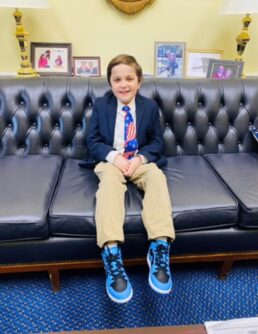
Conner advocating in Washington, DC
To date, KOMD has raised $2 million dollars, money that is primarily donated to research but also allocated to help other families in need. They have a benevolent assistance program to help buy wheelchairs and lifts, supplement financial support for modified vans, and cover expenses to send families to conferences. The Currans are also active advocates, often traveling to Washington DC to advocate for federal funding for research and connecting with Senators to raise awareness across the nation.
KOMD also hosts an annual event at the Captain Lawrence Brewing Company in Elmsford, NY. The ticketed fundraiser includes food tastings from local restaurants, an open bar, silent auction, a DJ, and an incredible sense of community. Jessica expects more than 600 attendees at this year’s event, which will be held on September 14. The night is an opportunity for friends and families to come together and contribute to a changing treatment landscape. “It’s truly an inspiring event,” Jessica says. “Because this is a devastating disease, but there is so much kindness and hope and joy in everybody coming together. It is magical. And we are excited about new and future treatment options.”
That valuable connection to the community is something that Jessica urges other parents to seek out. Through her involvement with the neuromuscular disease community, Jessica has had the opportunity to offer support and advice to other parents who may be considering gene therapy for their child.
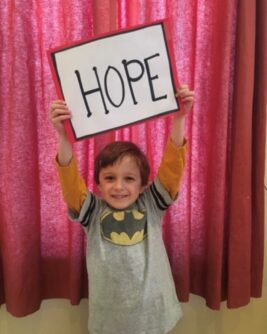
Gene therapy brings hope for the future
“Everyone’s path is a little different and every boy with DMD progresses differently. It’s a decision that is very personal,” Jessica says. “Talk to other families, connect with the MDA Gene Therapy Network, and do your research – but ultimately you have to follow your heart. That is what we did. As a family we have a strong faith in God, and we prayed about what was best for Conner. We have a lot of hope and we put our hope in this treatment. We hoped that it would really help Conner, and it did. It gave him his childhood back. I really believe that the future is bright for our boys with DMD.”
Next Steps and Useful Resources
- MDA’s Gene Therapy Support Network connects you to information, resources, and one-on-one support.
- Get the basics in MDA’s Virtual Learning webinar Gene Therapy 101.
- Watch a video about how MDA has led the way in gene therapy development research.
- Stay up-to-date on Quest content! Subscribe to Quest Magazine and Newsletter.
TAGS: Clinical Trials, Drug Development, Gene Therapy, My Gene Therapy Journey, Parenting
TYPE: Blog Post
Disclaimer: No content on this site should ever be used as a substitute for direct medical advice from your doctor or other qualified clinician.


